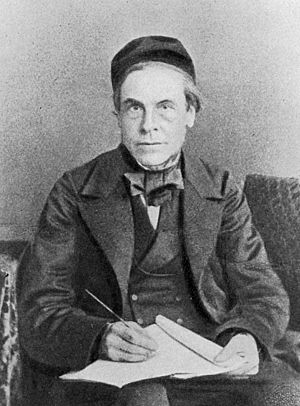Thomas Wharton Jones facts for kids
Quick facts for kids
Thomas W. Jones
|
|
|---|---|
 |
|
| Born | 9 January 1808 St Andrews, Scotland
|
| Died | 7 November 1891 (aged 83) Ventnor, England
|
| Nationality | English |
| Alma mater | University of Edinburgh |
| Scientific career | |
| Fields | Ophthalmologist and physiologist |
| Institutions | University College, London Royal Institution Charing Cross Hospital |
| Academic advisors | William Mackenzie |
| Notable students | Thomas Henry Huxley |
Thomas Wharton Jones (born January 9, 1808 – died November 7, 1891) was an important eye doctor (called an ophthalmologist) and a scientist who studied how living things work (a physiologist). He lived in the 1800s and made many discoveries about the human body, especially the eye.
Contents
Thomas Jones's Early Life and Studies
Thomas Jones was born in January 1808 in St Andrews, Scotland. His father, Richard Jones, worked for the government's customs office. Thomas grew up in Scotland and decided to study medicine at the University of Edinburgh.
From 1827 to 1829, he worked as an assistant to Robert Knox, who taught anatomy in Edinburgh. During this time, Thomas Jones was briefly involved in a major public scandal. He was questioned about a situation involving two criminals, Burke and Hare, who were known for illegal activities. However, an investigation found that Jones had done nothing wrong, and he was completely cleared.
After this, he moved to Glasgow. There, he worked with another famous eye doctor named William Mackenzie. Thomas Jones helped by drawing detailed pictures of the eye for Mackenzie's important book.
Discoveries and Career in Medicine
In 1835, Thomas Jones traveled to Cork, Ireland. For a while, he worked as a doctor there, focusing on eye and ear problems. In the same year, he made an important discovery: he found the "germinal vesicle" in the eggs of mammals. This was a big step in understanding how living things reproduce. In 1837, he also described how the "chorion" (a part of the developing embryo) forms.
Later in 1837, he visited many major universities in Europe. The next year, he settled in London and started his own practice as an eye doctor. In 1847, Jones looked at an early version of an ophthalmoscope. This is a tool used to look inside the eye, invented by Charles Babbage. However, Jones didn't find it very useful at the time.
In 1851, Thomas Jones became a Professor at University College, London. He taught Ophthalmic Medicine and Surgery, which means he taught about eye diseases and operations. He held this job for 30 years. In 1881, he had to retire because of health problems. He moved to Ventnor and lived there until he passed away in 1891.
Besides his main job, Jones also taught physiology at Charing Cross Hospital. He was also a Fullerian Professor of Physiology at the Royal Institution from 1851 to 1855.
Other Interests and Views
In 1872, Thomas Jones helped edit a book about the life of Bishop Bedell of Kilmore. This bishop was an ancestor of Jones and died during the Irish Rebellion of 1641.
Thomas Jones had different ideas about Darwin's theory of evolution. He didn't believe that humans evolved from apes. In 1876, he even published a book explaining why he thought Darwin's theory was "unsanctioned by science."
Awards and Recognition
Thomas Jones received several important awards for his scientific work:
- 1850: He won the Astley Cooper Prize for his essay on "State of the Blood and Bloodvessels in Inflammation." This essay was about how blood and blood vessels act when there is inflammation in the body.
- 1851: He received the Actonian Prize for his essay called "The Wisdom and Beneficence of the Almighty as displayed in the Sense of Vision." This award came with 100 guineas, which was a lot of money (£105) at the time. It was given by the Royal Institution.
Important Books and Papers
Thomas Jones wrote many important books and scientific papers. Here are some of them:
- The principles and practice of ophthalmic medicine and surgery (1847): This was a major textbook about eye medicine and surgery. It was published in several editions and countries.
- A catechism of the medicine and surgery of the eye and ear (1857): A simpler guide for students learning about eye and ear problems.
- A catechism of the physiology and philosophy of body, sense, and mind (1858): This book was for schools and colleges, explaining how the body, senses, and mind work.
- Failure of sight from railway and other injuries of the spine and head (1869): This book looked at how injuries to the spine and head could affect eyesight.
- A true relation of the life and death of the Right Reverend father in God William Bedell (1872): He edited this historical account about his ancestor, Bishop William Bedell.
- Evolution of the human race from apes, and of apes from lower animals, a doctrine unsanctioned by science (1876): This book explained his views against Darwin's theory of evolution.
He also wrote many other papers about physiology that were published in important scientific journals.
Groups He Belonged To
Thomas Jones was a member of several important scientific and medical groups:
- He was a Fellow of the Royal College of Surgeons.
- He was a Foreign Member of the Medical Society of Vienna.
- He was a Foreign Member of the Medical Society of Copenhagen.
- He was a Foreign Member of the Société de Biologie of Paris.

